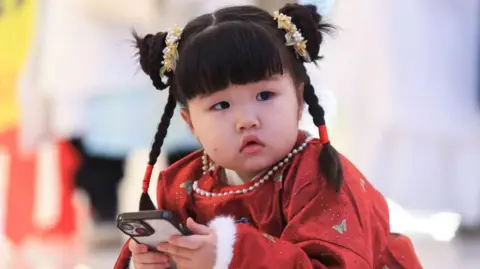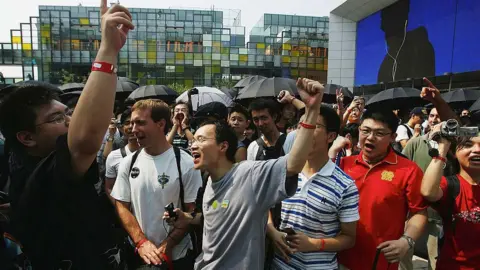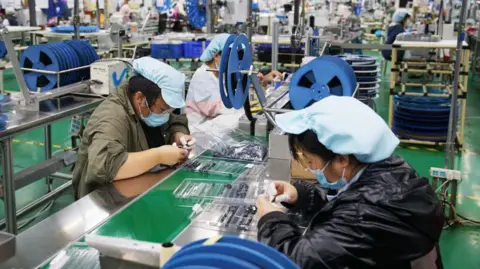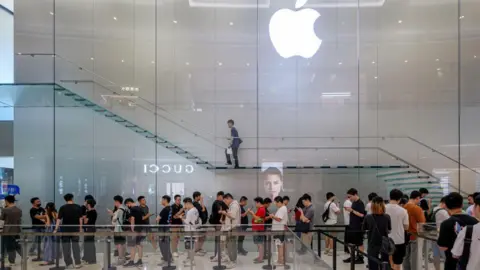Journalist
 Getty images
Getty imagesEach iPhone is delivered with a label that tells you that it has been designed in California.
While the elegant rectangle that manages several of our lives is indeed designed in the United States, it is likely to have come to life thousands of kilometers in China: the country has reached the most hard by the prices of American President Donald Trump, now going 245% on certain Chinese imports.
Apple sells more than 220 million iPhones per year and most of the estimates, nine out of 10 are made in China. From brilliant batteries to batteries, many components of an Apple product are made, purchased and assembled in iPads, Ipads or MacBook in China. Most are dispatched to the United States, the largest Apple market.
Fortunately for the company, Trump suddenly exempted smartphones, computers and other electronic devices from his prices last week.
But the comfort is short -lived.
The president has since suggested that more prices were coming: “no one is done” of the crochet “, he wrote on Truth Social, while his administration was investigating” semiconductors and the whole supply chain of electronics “.
The global supply chain that Apple has presented as a force is now a vulnerability.
The United States and China, the two largest economies in the world, are interdependent and Trump’s narcotic prices have turned upside this relationship overnight, leading to an inevitable question: who is the most dependent of the two?
How a life buoy has become a threat
China has enormously benefited from the accommodation of mounting lines for one of the most precious companies in the world. It was a business card to the west for quality manufacturing and helped stimulate local innovation.
Apple entered China in the 1990s to sell computers through third -party suppliers.
Around 1997, when he was about to go bankrupt as he was fighting to compete with competitors, Apple found a lifeline in China. A young Chinese economy opened up to foreign companies to stimulate manufacturing and create more jobs.
 Getty images
Getty imagesIt was not until 2001, but that Apple officially arrived in China, through a commercial company based in Shanghai, and began to manufacture products in the country. He joined forces with Foxconn, a Taiwanese electronic manufacturer operating in China, to make iPods, then imacs and subsequently iPhones.
While Beijing began to negotiate with the world – encouraged by the United States no less – Apple has increased its footprint in what became the world factory.
At the time, China was not ready to make the iPhone. But Apple chose its own supplier harvest and helped them to become “manufacturing superstars”, according to the expert in Lin Xueping supply chain.
He quotes the example of Beijing Jingdiao, now a leading manufacturer of high -speed precision machines, which is used to effectively manufacture advanced components. The company, which used to cut acrylic, was not considered a manufacturer of machine tools – but it finally developed machines to cut glass and has become “the star of the surface of the Apple mobile phone”, explains Mr. Lin.
Apple opened its first store in the country in Beijing in 2008, the year the city hosted the Olympic Games and the relationship of China with the West was on a record level. It quickly made snowball in 50 stores, customers queuing the door.
As Apple’s beneficiary margins increased, its mounting channels in China too, Foxconn exploiting the largest iPhone factory in the world in Zhengzhou, which has since been qualified as “iPhone City”.
For rapid growing China, Apple has become a symbol of advanced Western technology – simple but original and smooth.
Today, most of Apple’s precious iPhones are manufactured by Foxconn. The advanced chips that feed them are made in Taiwan, by the largest flea manufacturer in the world, TSMC. Manufacturing also requires rare earth elements that are used in audio applications and cameras.
According to an analysis by Nikkei Asia, some 150 of the 187 main Apple suppliers had factories in China.
“There is no supply chain in the world that is more critical to us than China,” said Apple CEO Tim Cook in an interview last year.
 Getty images
Getty imagesThe price threat – fantasy or ambition?
The first term of Trump, Apple obtained exemptions on the prices he imposed on China.
But this time, the Trump administration made an example of Apple before it has reversed the prices on certain electronics. He believes that the threat of high taxes will encourage companies to make products in America instead.
“The army of millions and millions of human beings screwing small screws to make iPhones – this kind of thing will come to America,” said trade secretary Howard Lutnick in an interview earlier this month.
The white house press secretary Karoline Leavitt reiterated this week: “President Trump clearly indicated that America cannot count on China to make critical technologies such as semiconductors, fleas, smartphones and laptops.”
She added: “In the direction of the president, these companies are jostling in the world of their manufacture in the United States as soon as possible.”
But many are skeptical about it.
The thought that Apple could move its assembly operation to the United States is “pure fantasy”, according to Eli Friedman, who previously ensured the academic advisory council of the company.
Friedman said that the company was talking about the diversification of its supply chain far from China since 2013, when it joined the Board of Directors – but the United States has never been an option.
He added that Apple did not make a lot of progress during the next decade, but “really made an effort” after the pandemic, when the well -controlled covored locking of China harm manufacturing production.
“The new most important locations for assembly were Vietnam and India. But of course, the majority of the Apple assembly still takes place (in China).”
Apple did not answer the BBC questions, but its website indicates that its supply chain extends over “thousands of companies and more than 50 countries”.
 Getty images
Getty imagesUpcoming challenges
Any modification of the status quo of the Apple’s current supply chain would be a hard blow for China, which tries to launch post-paymic growth.
Many reasons why the country wanted to be a manufacturing center for Western companies in the early 2000s, it is true today – it created hundreds of thousands of jobs and gives the country a crucial advantage in world trade.
“Apple is at the intersection of American-Chinese tensions, and the prices highlight the cost of this exhibition,” explains Jigar Dixit, consultant in supply chain and in operation.
This could explain why China did not bow to Trump’s threats, retaluating in place with 125% of American import samples. China has also imposed export controls on a range of minerals and criticism of the rare land it has in stores, blowing a blow in the United States.
There is no doubt that American prices are still taken from other Chinese sectors that will harm, however.
And it is not only Beijing in front of higher prices – Trump clearly indicated that it would aim for the countries that are part of the Chinese supply chain. For example, Vietnam, where Apple moved the production of AirPods, faced 46% of prices before Trump affects 90 days, so the movement of production elsewhere in Asia is not an easy outcome.
“All the imaginable places for the huge Foxconn assembly sites with tens or hundreds of thousands of workers are in Asia, and all these countries are faced with higher prices,” said Friedman.
So what is Apple doing now?
 Getty images
Getty imagesThe company is fighting for strong competition from Chinese companies while the government is pressure for the manufacture of advanced technologies in a race with the United States.
Now that “Apple has cultivated the electronic manufacturing capacities of China, Huawei, Xiaomi, Oppo and others can reuse the mature supply chain of Apple”, according to Mr. Lin.
Last year, Apple lost its place as a biggest seller of Chinese smartphones against Huawei and Vivo. The Chinese do not spend sufficiently due to a slow economy and with a chatpt prohibited in China, Apple also has trouble maintaining an advantage among buyers in search of telephones fueled by AI. He even offered rare reductions on iPhones in January to increase sales.
And while operating under the increasingly narrow adhesion of President Xi Jinping, Apple had to limit the use of Bluetooth and Airdrop on its devices while the Chinese Communist Party sought to censor the political messages that people shared. He resisted a repression against the technology industry that even affected the founder of Alibaba and several billionaires Jack Ma.
Apple announced an investment of $ 500 billion (378 billion pounds sterling) in the United States, although it may not be enough to appease Trump administration for a long time.
Given the multiple towers and uncertainty around Trump’s prices, more unexpected samples are expected – which could again leave the business with a small maneuver room and even less time.
Mr. Dixit says that smartphones prices will not paralyze Apple if they are raising their head again, but it doesn’t matter “the pressure – both in operational and politically” to a supply chain that cannot be taken quickly.
“It is clear that the severity of the immediate crisis has been reduced,” said Friedman, referring to last week’s exemption for smartphones.
“But I really don’t think it means Apple can relax.”
Additional reports by Fan Wang



